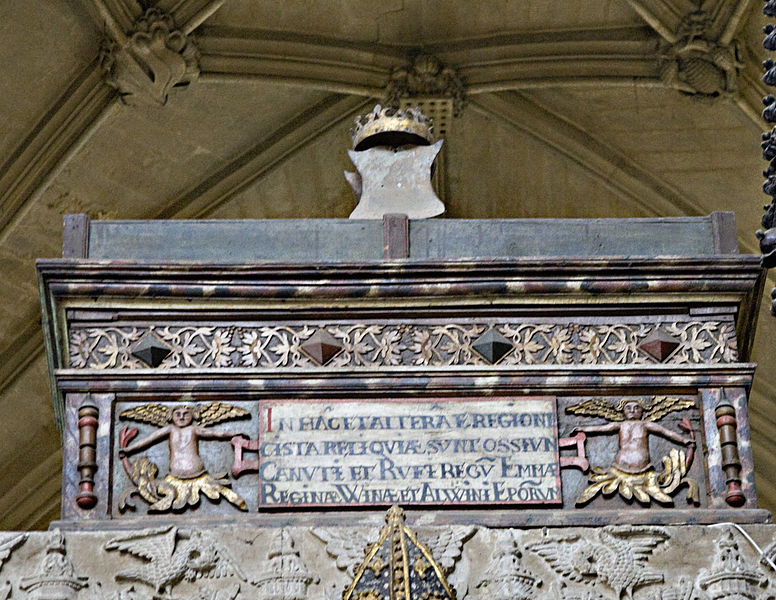Cnut, king of England, Denmark and Norway, died on 12 November 1035.

Photo: Wikimedia Commons
It is difficult to know his exact age at the time of his death because, like so many royals in this period, his birth date was not recorded. Given what we do know, though, it’s believed that he was somewhere between 40-45 years old.
There are, however, a couple of unresolved mysteries about Cnut’s death.
The Anglo-Saxon Chronicle tells us that he passed away at Shaftesbury Abbey, and the first mystery is why he was at the abbey in the first place. One theory is that because this institution of nuns had an infirmary, Cnut may have gone there because he was ill and he was seeking medical care. Or perhaps he wished to pray for his recovery at the abbey’s shrine of St. Edward the Martyr who was buried there.
However, given that Cnut’s death was followed by a great deal of turmoil over who should succeed him, it appears that he had no opportunity to put the affairs of his three kingdoms in order before he passed, so perhaps he had not been ailing, and death caught him unawares.
His visit to Shaftesbury may simply have been a stop on one of the many progresses that he made throughout England on a regular basis. The royal family and the court were peripatetic. They moved around a lot, from royal estate to royal estate, sometimes from abbey to abbey. Shaftesbury Abbey had several royal links that would have made it a compelling destination for the king and his court. It was founded by Alfred the Great in 888, its first abbess was Alfred’s daughter AEthelgifu, and it was a pilgrimage site because of the shrine of King Edward the Martyr.
Working on the theory that Cnut’s death was unexpected, Danish coroner Jorgen Lange suggested in his 2015 book “Why Did the Kings Die?” that because Cnut, his father, his brother, and his sons all appear to have died suddenly, they may have suffered from Brugada Syndrome.* It’s a genetic heart disease characterized as a disturbance in the conduction system of the heart that carries the increased risk of sudden cardiac death, which can happen at any age. So it might have been Cnut’s heart that failed and led to his death.
His heart is certainly the centerpiece of the second mystery about his passing. In the early 20th century, a glass bowl dated 9th-10th century, was found buried beneath a heart-shaped marble slab in front of the Abbey’s high altar.

Photo: Wikimedia Commons
Known as the Shaftesbury Bowl, there is a theory that it may have contained the heart of King Cnut. It hasn’t been proven that this bowl once held Cnut’s heart, but glass vessels from this period were used for that purpose in royal burial practices.
So, was Cnut’s heart buried at Shaftesbury? It seems to us today, (at least, to me) that it would have been quite an assault on the king’s remains to take out the heart in order to bury it in a separate tomb. However, this procedure may be related to the fact that the king’s body had to travel 45 miles before its burial at Winchester. Today we can drive that in 90 minutes, and walk it in 2 days. But in the 11th century, in mid-November’s wet weather, with a cortege that included the king’s hearth troops, his family, members of his court and numerous attendants, the procession would have traveled at the most only 6 hours each day, so it would have taken a week or longer.
In medieval times, if the funeral of a royal, a noble, or a member of the high clergy had to be delayed—for instance, because of travel—the body would have been embalmed: organs were removed, including the heart, and the cavity was washed and packed with a combination of aromatic herbs and spices before the body was wrapped in linen. Shaftesbury Abbey certainly had the herbs and spices necessary for this process. Nor was it all that unusual for the heart of a king to be embalmed separately and placed in its own coffin at a site distant from the royal tomb to show that the ruler had a claim to other parts of the country.
In Cnut’s case, it’s possible that, because the body had to be embalmed for travel anyway, the nuns at Shaftesbury may have requested that the king’s heart be buried near the relics of Saint Edward; or, because of Shaftesbury’s royal associations, a member of Cnut’s family may have determined that his heart should remain there. No one could have foreseen that 500 years later, another king would destroy King Alfred’s foundation, Saint Edward’s shrine and leave behind only ruins of the abbey and its royal connections.

Shaftesbury Abbey today

Shaftesbury Abbey pre-1539. The church in Cnut’s time would have been smaller, but it was still a large and wealthy abbey in the 11th century.
The Shaftesbury Bowl resides now somewhere in Winchester Cathedral. The bones of the king, his queen Emma, and his son Harthacnut are interred in mortuary chests placed high on the stone screens of the presbytery. Meantime, the two mysteries surrounding Cnut’s death will likely remain forever unsolved.

* https://cphpost.dk/2015-10-16/general/mystery-of-danish-king-deaths-fosters-new-theory/